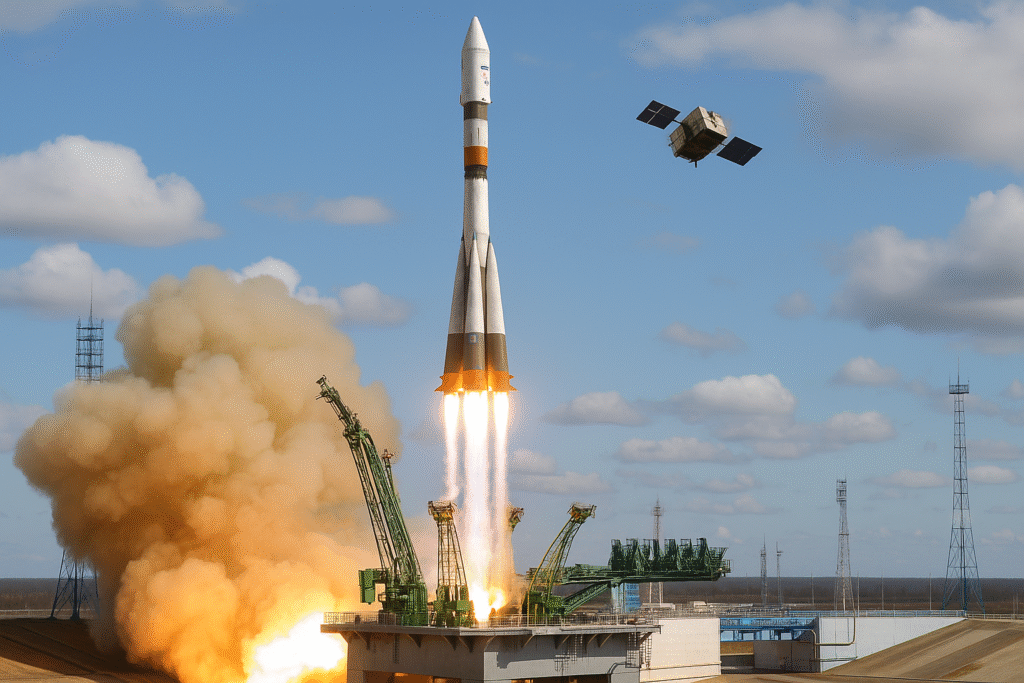In a world where technological advancement increasingly defines geopolitical power, the recent Russian launch of an Iranian communications satellite marks a significant milestone in international collaboration. On Friday from the remote Vostochny Cosmodrome in far eastern Russia a Soyuz rocket thundered into the sky carrying Iran’s Nahid-2 satellite, two Russian Ionosphere-M satellites and 17 other small payloads. While at first glance it may seem like just another space launch this mission is emblematic of a growing strategic partnership between Moscow and Tehran.
With both countries facing increasing isolation from Western powers, this space venture underscores not just a technological achievement, but a new chapter in geopolitical alignment. The successful deployment of the Iranian communications satellite is more than a symbol of ambition it is a carefully coordinated maneuver with profound implications.
The Nahid-2 Mission A Technological Leap for Iran
Iran’s Nahid-2 satellite represents a leap forward in its domestic aerospace capabilities. Developed by the Iranian Space Research Center, Nahid-2 is designed for geostationary communications, offering capabilities like real time telecommunications, internet expansion, and emergency response coordination. According to Iran’s Ministry of Information and Communications Technology, this satellite is a pivotal step in the country’s broader goal to create a national space infrastructure independent of Western technologies.
Technical Highlights of Nahid-2
Mission Duration: Estimated operational lifespan of 2.5 to 3 years. S-band transmission, signal encryption, data relay. Lightweight and compact, with solar panels for sustainable energy.
The deployment of an Iranian communications satellite in such a high stakes international context reflects how vital space technology has become in Iran’s vision of future proofing its sovereignty.
Russian Iranian Cooperation A Case Study in Strategic Necessity
This joint mission is not the first time Iran and Russia have collaborated in space. In 2022, Russia launched Iran’s Khayyam satellite, sparking international concerns about dual use capabilities. This current launch serves as a case study in how isolated nations find innovative pathways to circumvent sanctions and technological blockades.
Russia’s Role in Iran’s Satellite Development
In 2020, Iran’s efforts to launch satellites faced multiple setbacks due to U.S sanctions and sabotage attempts. With limited access to international launching facilities and commercial satellite technology, Iran turned to Russia, whose Vostochny Cosmodrome is not subject to Western restrictions. According to aerospace analyst Pavel Luzin, Iran’s collaboration with Russia isn’t just about access to rockets it’s about transferring institutional knowledge and deepening long term alliances.
By enabling Iran to launch its satellite, Russia not only supports an ally but cements its own relevance in the commercial and strategic space race. This reinforces Russia’s role as a global provider of launch services, despite increasing Western economic pressure.
Expert Opinions Reactions from the Global Space Community
The space and defense communities are closely monitoring this cooperation. Dr. Laura Grego, a senior space expert at the Union of Concerned Scientists noted. While the Nahid-2 appears to be a purely civilian telecommunications satellite, the launch partnership highlights how geopolitical dynamics can shape the future of space access and control.
Meanwhile, Iranian officials like Isa Zarepour, Iran’s Minister of ICT, have praised the successful launch as a sign of their self sufficiency and technological maturity. Today is a proud day for Iran. The Nahid-2 Iranian communications satellite represents not only our engineering triumph but also our resilience.
The Human Side of Space Innovation
For engineers and scientists working behind the scenes, the mission was not merely technical it was deeply personal. Dr. Mohsen Kalantari, an Iranian aerospace engineer who worked on the Nahid-2 project. We worked tirelessly, often under pressure and limited resources, to bring this dream to life. Watching it launch into the sky from Russia was emotional. It was as if a piece of our soul had taken flight.
Such personal accounts remind us that space missions aren’t just numbers and physics they’re human stories filled with dreams, obstacles, and triumphs. For nations like Iran, where scientific advancement often walks a tightrope with politics, every milestone carries emotional and nationalistic weight.
What This Means for the Future
This launch has multiple dimensions technological, political, and diplomatic.
For Iran: It reinforces self reliance in tech innovation and provides critical telecommunications infrastructure.
For Russia: It showcases continued prowess in launch capabilities and sends a clear message of alliance building.
For the world: It raises questions about space regulation, sanctions circumvention, and future alliances outside Western frameworks.
Additionally, the deployment of the Iranian communications satellite allows Iran to bolster its internal communications infrastructure, potentially improving digital inclusion and emergency response in rural and remote areas.
A New Era in Space Geopolitics
The Russian launch of the Iranian communications satellite is far more than a routine rocket mission it’s a bold declaration of a shifting global space order. As alliances morph in the face of sanctions and new technological thresholds, this collaboration stands as a testament to innovation driven by necessity.
With Nahid-2 now in orbit, the world watches with bated breath. What will this partnership mean for the Middle East? How will the West respond to this growing space collaboration between Russia and Iran? Time will tell but one thing is clear the final frontier is now a chessboard for power, progress, and international positioning

